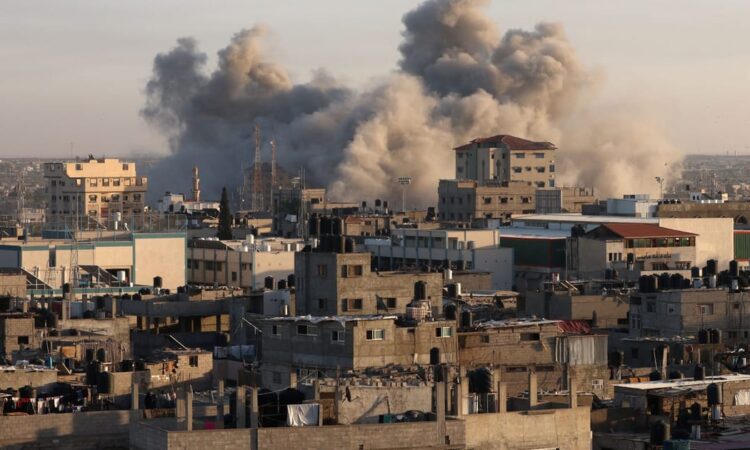
Press play to listen to this article
Voiced by artificial intelligence.
Isabel Oakeshott is international editor at Britain’s Talk TV.
A little over a fortnight after the Hamas attacks on October 7, global money-laundering experts gathered in Paris to discuss how to disrupt the flow of money to terrorists.
Among the delegates were representatives from Interpol, the International Monetary Fund (IMF), the United Nations and the World Bank. Top of the agenda was the Middle East, with the Financial Action Task Force (FATF) — which monitors 40 countries’ efforts to tackle dirty money — at pains to highlight the challenges faced by those responsible for identifying and disrupting the increasingly complex and opaque structures and systems used to hide money by extremists.
Orchestrating even small-scale atrocities and suicide bombings takes money; killing and maiming on the scale of October 7 costs millions. And against this backdrop, the global campaign to tackle illicit money flows has taken on new urgency. The stakes could not be higher, but when it comes to Gaza, agencies are looking in the wrong direction.
Overall, the current landscape has made tackling money laundering increasingly difficult. For one, the rise of cryptocurrencies has complicated the task, allowing millions of anonymous transactions. The number of exchanges registered on the Bitcoin network has now reached almost half a million a day.
Equally worrying is the growing use of crowdfunding. In a kind of reverse money laundering, “clean” cash donated by well-intentioned individuals and organizations who think they’re supporting honorable causes is increasingly being used to pay for guns and military material.
Research by the FATF, highlighted at the Paris meeting, suggests that the Islamic State (IS), al-Qaida and other terrorist groups are increasingly turning to crowdfunding platforms.
Meanwhile, intelligence agencies and other authorities are doing their best to keep up, while the FATF calls out governments that turn a blind eye, naming and shaming countries that take insufficient measures to stop dark money flowing to terrorists and the criminal underworld.
For now, only three regimes are considered so lax in their approach that they’ve been put on a “blacklist,” and those are Iran, North Korea and Myanmar. However, some 23 countries are on a gray list — meaning they’re subject to increased monitoring — and the status of other countries is about to be reviewed.
For example, India should be feeling particularly nervous. An FATF investigation into its performance began this week. Last time the country was inspected in 2010, multiple shortcomings in anti-money laundering measures were exposed.
Since then, the government’s grip on the problem appears to have dramatically weakened, with experts valuing money laundering via illicit trade at up to 5 percent of India’s GDP. In the context of a booming economy — the country’s GDP recently broke through the $3.75 trillion mark — that’s a huge number.
India’s intelligence agencies and police are in no doubt about the links between illicit funds and drugs, terror and crime syndicates. And a recent report by the Federation of Indian Chambers of Commerce & Industry described this as a “major threat to the country’s economy and security,” urging Prime Minister Narendra Modi to go on a “war footing” against money laundering.

Thus, the FATF’s eventual assessment, due in just a few months, will be an interesting test of how tough the organization is ready to be.
In relation to Hamas, however, all this is just tinkering around the edges. Israeli and United States intelligence agencies believe Iran funnels up to $100 million a year to Hamas — but what about the hundreds of millions sent to Gaza by the U.N.?
Funded primarily by the U.S. and the European Union, the U.N. Relief and Works Agency (UNRWA) effectively underpins Hamas in Gaza, providing almost all essential public services in the territory, including education, health care, key infrastructure and food supplies. Without the UNRWA, everyday life in the Gaza strip — desperate and dysfunctional as it is — would collapse.
Hamas, the official government, seems neither willing nor able to provide these basics, let alone grow the economy and create opportunities for a better life for all.
When the UNRWA was first established in 1949, following the Arab-Israeli war, it supported around 700,000 displaced people — today, it caters to around 5.6 million individuals designated as refugees. And over the years, there’s been compelling evidence the agency is fueling Palestinian extremism, whether by employing individuals affiliated with Hamas or condoning the use of textbooks and materials in UNRWA-run schools that delegitimize Israel and denigrate Jews.
Hamas has also been known to use the agency’s facilities to store weapons, hide entrances to tunnels and divert aid for its own purposes.
In August 2018, then–U.S. President Donald Trump withdrew funding to the UNRWA, labeling it an “irredeemably flawed operation.” And when current President Joe Biden reversed the decision, the U.S. State Department warned of a “high risk” that Hamas could “potentially derive indirect, unintentional benefit from U.S. assistance to Gaza.” But Biden ignored this advice, and so the aid continues to flow.
So while the IMF, the World Bank, Interpol and the like can hand-wring about hidden dirty money all they like, in Gaza, the biggest source of financial support for terrorism is arguably hiding in plain sight.






